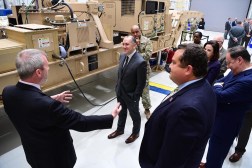DOD tests new machine learning capabilities for JADC2

The Department of Defense recently concluded a round of tests of new machine learning technology that aims to increase data sharing between combatant commands.
The North American Aerospace Defense Command and Northern Command’s Global Information Dominance Experiment 3 (GIDE 3) brought 11 combatant commands, the Joint Artificial Intelligence Center (JAIC) and other tech leaders together July 8-15 at Peterson Air Force Base in Colorado to test the use AI in warfare.
The GIDE experiments aim to advance tech that will enable the DOD’s new concept of how it will fight in the future, where data from across military domains will be shared between machines and AI will assist commanders in their decision-making. The idea is captured in the department’s larger strategy of Joint All Domain Command and Control (JADC2), which is a guiding framework for many experiments like GIDE 3 and others across the services.
“The GIDE 3 experiment showcased how the software tools designed for cross-combatant command collaboration, assessment, and decision-making can be used to enable more effective global logistics coordination, intelligence sharing and operations planning,” said Gen. Glen VanHerck, NORAD and NORTHCOM commander.
The third phase of the GIDE experiments focused on testing the JAIC’s new Matchmaker tool, designed to create defensive options by reading real-time data from the field and analysis assessments from analysts, according to a release from the Air Force. The tool is meant to provide a core capability within JADC2 of linking and analyzing data from across domains, replacing the current process of human analysts talking over radios with data often siloed between domains.
“By integrating more information from a global network of sensors and sources, using the power of AI and machine-learning techniques to identify the important trends within the data, and making both current and predictive information available to commanders, NORAD and USNORTHCOM are giving leaders around the globe more time to make decisions and choose the best options available, whether in competition, crisis or conflict,” VanHerck said.
The first two GIDE experiments focused on how to coordinate early warning alerts between a handful of commands using AI and how to collaborate on logistics during war. The third test in mid-July was the final GIDE experiments hosted by Northern Command and NORAD, which has been an early adopter of AI and JADC2-related tech.
The two homeland defense commands also run the Pathfinder program, which uses AI to detect air threats like incoming missiles or even small drones.






